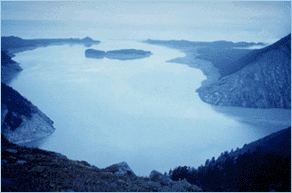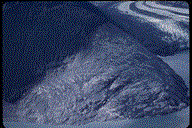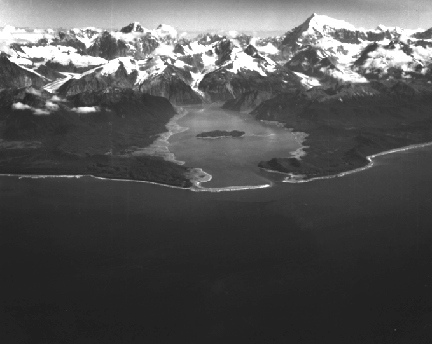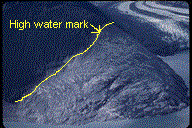World Record Tsunami
 Whoa! You're thinking... what is a tsunami and I don't see a huge wave in the picture, anywhere. Well, a tsunami (it's actually a Japanese word) is a word scientists use to describe an enormous wave (or series of waves) that happens when an enormous amount of energy is released into the waters of the ocean creating a ripple effect, like when you drop something in the bathtub or throw a rock into a lake. Only the "ripples" come from:
Whoa! You're thinking... what is a tsunami and I don't see a huge wave in the picture, anywhere. Well, a tsunami (it's actually a Japanese word) is a word scientists use to describe an enormous wave (or series of waves) that happens when an enormous amount of energy is released into the waters of the ocean creating a ripple effect, like when you drop something in the bathtub or throw a rock into a lake. Only the "ripples" come from:
1) an earthquake (movement of the sea floor)
2) a volcanic eruption (lava and rock going "kersploosh" into the sea)
3) a huge landslide, as was the case in Lituya Bay
The incredibly massive size of the material 'plopping' into the ocean (or the shifting of the sea floor) creates MAJOR ripples that are so big they are gigantic waves traveling at speeds of up to 200 mph/320kph over really long distances in the open sea. But, when the waves reach the beach they are incredibly high and wash way inland causing major damage and sometimes loss of life.
SO, you're asking, why no wave in the picture? Well, close up shots of tsunamis actually happening are pretty rare and hard to get, as you can imagine. Would YOU stand on the shore with a camera to take a picture of a ten-story high wave coming right at you? Most people turn and run for the hills because their lives are in serious danger.
What happened at Lituya was movement along the fault that runs from left to right in the above picture. If you pretend you're actually standing on the ridgetop looking out over the Bay (like the view in the above picture) the fault would be in the mountains behind you. The "movement in the fault", of course, is called an earthquake. The magnitude of the quake was about 8.3, although some
 This photo shows the damage to the headland; every living thing was completely wiped off where the first major wave struck. |
sources say it was a 7.9, on the Richter Scale (a scale for measuring the magnitude, or amount of energy released, from an earthquake). Pretty awesome shaker. Well, shaker it was...it "shook" loose an estimated 40 million cubic yards of dirt and glacier from a mountainside at the head of the Bay, about where you're standing in the above picture. When the stuff went "kersploosh" into the water it created a massive wave that washed 1,720 ft/524m high over the headland in the right side of the above picture. The tsunami inundated approximately 5 square miles of land along the shores of Lityua Bay, sending water as far as 3,600 feet inland, and clearing millions of trees.You can see the damage to the trees that were growing on the headland when the wave washed over the top of it - there were no trees left...wiped 'em clean off. The picture above gives you a closer view of the damage to the headland that the tidal waves caused.
There were three fishing boats anchored at the mouth of Lituya Bay on the day the awesome waves
 U.S.G.S. Aerial photo of Lituya Bay taken after July 9, 1958 event. Note the extent of the non-forested areas of land lining the shore of the bay, which marks the approximate reach of the tsunami's runup. |
happened. That's the main reason we know it happened. There were human witnesses to the catastrophic event. Unfortunately, one of the boats was close to shore and the huge waves overtook it killing the two people on board. Amazingly, the other two boats "rode" the tidal waves as they washed from the source of the landslide and resonated around the bay, like water sloshing in a wash basin. The boaters watched in horror as the first enormous wave engulfed the small fishing boat and wiped everything in its path off the land. If there had been a town or city on the shores of the bay everyone in it would have been killed. Fortunately, because it was an unpopulated area, the loss of life was minimal (although, the family of the victims hardly think that it was good fortune).
How Do They Know?
To measure the height of the biggest wave, all scientists had to do was look for the high water mark - that's the line where the water reached its highest point on the nearby land. It's real easy to find you just look for the uppermost edge of the damaged area (see photo at left).
Then, they measured the elevation of the highest point on the high water mark to get a measurement of 1,720 ft/524 high - the biggest wave ever measured.
 The yellow mark illustrates the maximum height the wave reached as it washed over the headland. |
There are waves out on the ocean all the time, which are created by the friction, or the dragging motion, of the wind over the vast surface of the sea. When big storms develop out at sea creating fast winds it causes really big waves, called storm waves. Ships out at sea during these really big storms have experienced some pretty big waves, some as much as 100 ft/31m high, but that's about as big as storm waves get out on the open sea. Nothing like the "big one" at Lituya Bay.
Here's something to think about...There happened to be people fishing in the Bay the day that the landslide and resulting tidal wave occurred. That part of Alaska is not populated, but people come to that area for many reasons. There are places on this earth that are so inhospitable (really bad) that few people ever visit. For example, the Arctic, or the Antarctic, in winter are some pretty nasty, cold places. Not only are they not fun places to visit, but they're virtually inaccessible to humans in winter. It's totally possible that in early spring, when the ice starts to melt, and glaciers calve into the ocean (break off HUGE chunks) that really big waves occur. Possibly even bigger than the massive one at Lituya Bay! The wave may wash up over ice and ice-covered land, but the evidence melts away so that no human ever knows it happened.
We say that the tsunami at Lituya Bay was the biggest wave ever, but that's just the ones humans have witnessed and have been able to record. There have probably been even BIGGER waves that have happened in the past when human witnesses didn't even exist. And you never know, there may even be a bigger wave to happen yet!
No comments:
Post a Comment